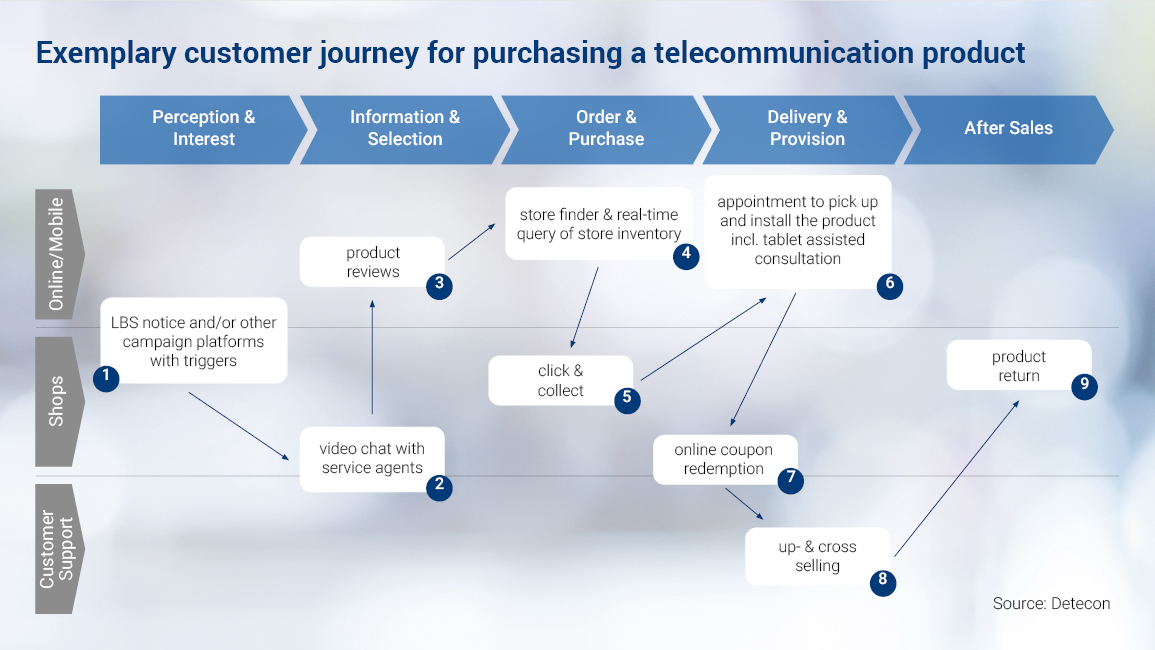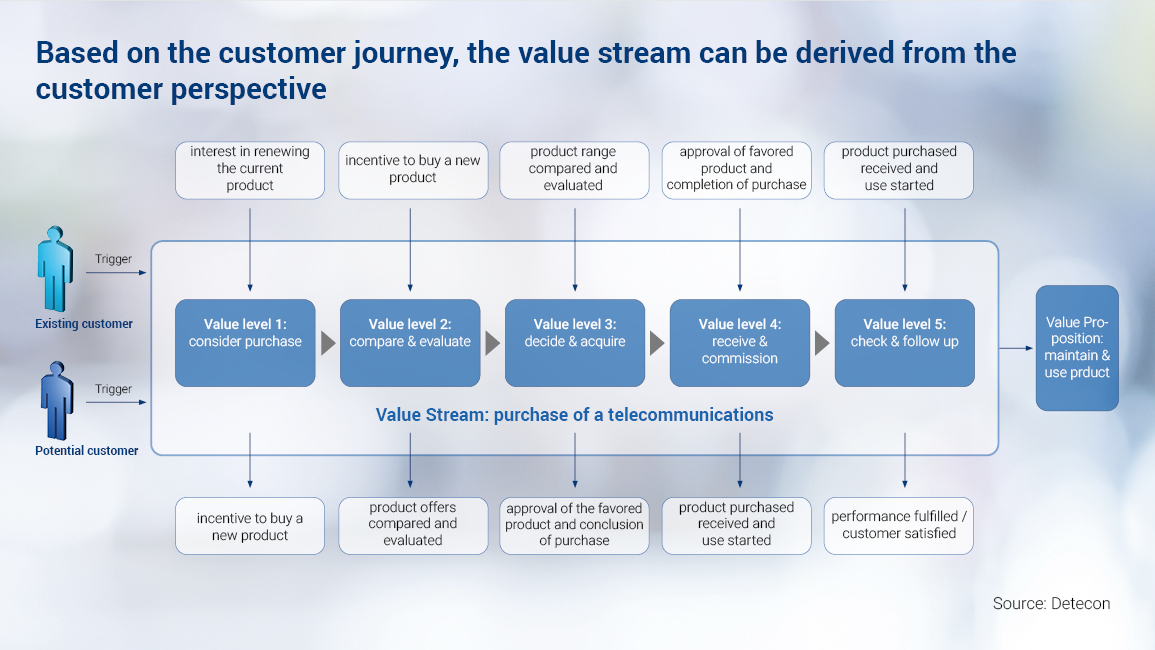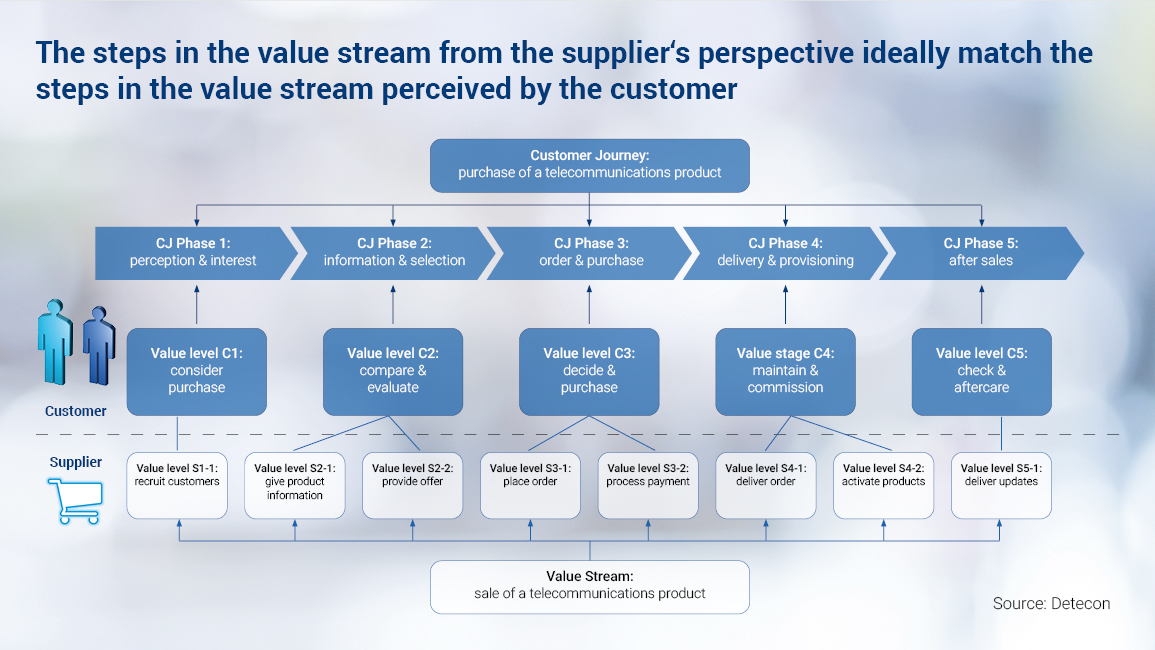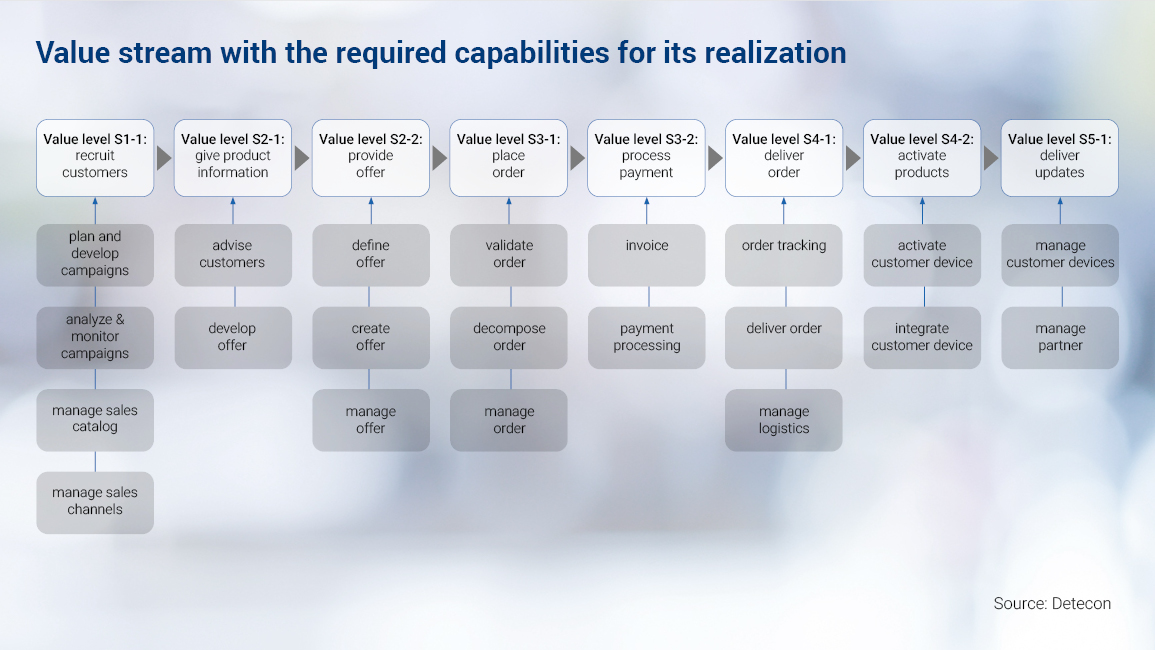Value stream mapping provides important information for designing an agile collaboration model. To ensure that the most important information - the customer's view - is not overlooked, we recommend linking the value stream analysis with the customer journey. Our Agile Coaches Michael Spiller and Andreas Penkert show how it's done.
The basic idea of an agile organization lies on the one hand in customer centricity, and on the other hand in the continuous creation of value. In line with the objective of lean methods to identify and eliminate activities that do not add value, all work and activities, from the idea to the handover of the product to the customer, are improved iteratively.
The totality of these activities for a product forms the value stream. Accordingly, a value stream is the ideal starting point when setting up an agile transition.
But how do you actually identify the value stream for a product? And does this automatically put the customer at the center of the consideration?
How well do you really know your value stream?
In our value stream mapping workshops, we repeatedly find that the participants are sure that they already know their value stream at the beginning. However, as soon as it comes to the concrete recording of the individual steps, an effect of "silo thinking" sets in.
It is true that the participants are well aware of the work and activities they themselves perform in the value stream. However, the services performed by others are often hardly known or even unknown.
This is all the more astonishing when you learn that many of the participants have been working on the product for years and still don't know who exactly does what and at what intensity orders, requests or even regressions such as bug fixes occur.
Why is understanding your own value stream so important?
As agile coaches, we always recommend identifying the value streams in the company before an agile transformation. We want to make transparent which work and activities provide a value contribution during product creation. At the same time, it is about understanding by whom these value-creating steps are performed.
With this information, we can derive which people with which skills work together in agile teams and which people should coordinate or synchronize with what regularity.
An analyzed value stream therefore represents the input variable for being able to set up an agile collaboration model at all. The phases of a value stream can be mapped well with a Kanban.
On this basis, we can thus make the flow through the value stream transparent and identify waste by analyzing throughput times - thus laying the foundation for continuous improvement.
Why are "classic" value stream analyses not enough?
A "classic" value stream mapping workshop starts with the trigger of the value creation process. This can be project orders, change requests, bug reports or similar.
Then we look at the final step of the value chain. In most cases, this is the handover of the product to the customer, for example delivery or provision.
With the identification of the trigger and endpoint, the framework is set; the analysis then extends to the value-adding steps in between. For each step, it is documented which persons, teams, roles or departments perform the activities and work in the respective step. Once the entire value stream has been mapped out, in-depth analyses reveal potential for improvement.
So far, so good. In our opinion, however, this analysis too often forgets the person who is supposed to consume the product or service or for whose problem a solution is supposed to be found: the customer. At best, a " dummy consideration " is made by trying to simulate the customer's point of view starting from oneself.
However, this approach does not focus on the customer perspective, but rather promotes tunnel vision and thus harbors the danger of a value stream analysis that bypasses the customer. We consider the change in perspective that customer-centric approaches such as the Design Thinking method have set in motion in recent years to be absolutely necessary here as well.
How can value streams be identified using customer journeys?
In order to take greater account of the customer's perspective, we are increasingly working with customer journeys in value stream mapping. A customer journey takes into account all of the customer's points of contact with a provider and his product/service, including a description of his experiences and subjective perceptions during this "journey".
The customer journey is an excellent method for gaining a deep understanding of our value stream from the customer's perspective. Figure 1 shows an example of a customer journey for the purchase of a telecommunications product.

While the participants in a "classic" value stream workshop are usually mainly product developers, it is important to have marketing specialists, product managers and other experts present when analyzing a customer journey. They understand and represent the customer's point of view.
Ideally, the customer is asked for his view and assessment of things in interviews or even directly involved in the process. We do not accept the argument of disproportionality at this point - especially with regard to value stream mapping, this enables particularly valuable knowledge.
If no real customer feedback can be obtained, it helps to model and describe your own customer in the form of representative personas. Personas can provide a good approximation of the (representative) customer type as part of a creative process.
The persona methodology imagines typical users of a product or service as real people - with individual biographies, character traits, needs, interests, problems and fears.
Which activities are actually relevant for customers?
Each step of the customer journey can be related to a step of the value stream. In Figure 2, we have shown this as an example with our fictitious value stream for the purchase of a telecommunications product.

Starting from the contact points perceived by the customer, we identify the steps of the value stream. We then identify the upstream and downstream steps in the value stream from the supplier's perspective, which may not be perceived by the customer.
Ideally, these steps can all be assigned to one step of the customer perspective. In this way, we make it transparent that these steps enable the perceived services at the customer.
This is precisely the main advantage of our approach: Based on the customer's view of the value delivery provided by the customer journey, we consciously enforce the question of the extent to which value is created for the customer at every step in the provider's value stream. This means that the customer really is at the center!
In Figure 3, we have applied our approach described above to the example involving the purchase of a telecommunications product. We have marked the steps in the value stream from the customer's perspective with "C" and those from the supplier's perspective with "S". The illustration makes it clear that thanks to this approach, important discussions regarding the relevance and necessary quality level of the steps in the value stream are promoted at a very early stage.

What skills satisfy my customers?
Next, we identify the capabilities needed to realize the steps of our value stream. We have illustrated this for our exemplary value stream in Figure 4. In addition, these capabilities can be prioritized according to relevance using the MoSCoW method (Must have - Should have - Could have - Won't have), for example. This makes it possible to check whether the focus of resource allocation has been set correctly so far.

How does the agile organization derive from the value stream?
Finally, we have identified all customer touchpoints, value-adding work and activities, and the skills required for them. With this information, we can identify the team cut, the required roles, and the necessary coordination and synchronization points - also with other in-house or external parts of the organization - and design an agile collaboration model.
Depending on the customer's requirements, we can determine one of the two starting points:
- We map the as-is state and improve it iteratively through an agile approach based on this state,
- We directly define an optimized target image of the customer journey and the value stream and subsequently design the agile model for this.
Are you interested in optimizing your value creation together with us? Then let's get in touch!









